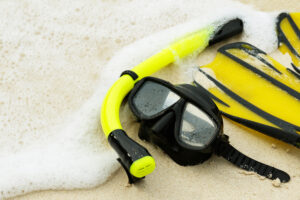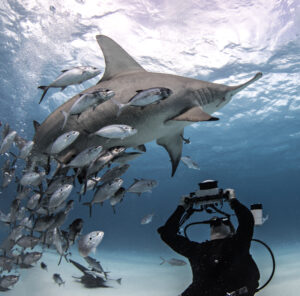What is a Rash Vest?
A rash vest, also known as a rash guard, is a type of athletic shirt made from spandex and nylon or polyester. Originally designed to provide sun protection and to prevent chafing from surfboards, rash vests have become an essential piece of gear for many water sports enthusiasts, including surfers, swimmers, and scuba divers. They are particularly valued for their ability to protect the skin from rashes caused by abrasion, UV rays, and stings from marine creatures. In scuba diving, rash vests serve additional functions, enhancing comfort and safety under various underwater conditions.
History and Origin of the Rash Vest
The history of the rash vest is closely linked to the evolution of surfing. In the mid-20th century, surfers in Australia began wearing simple cotton shirts to protect their skin from the harsh sun and abrasive surf wax on their boards. However, cotton quickly proved to be inadequate as it became heavy and uncomfortable when wet. This led to the development of the modern rash vest, using lighter and more flexible materials such as spandex and polyester.
Throughout the 1970s and 1980s, the popularity of rash vests grew among surfers and other water sports enthusiasts. These early rash vests were primarily designed to prevent chafing and rashes, hence the name. Over time, manufacturers began incorporating additional features such as UV protection and thermal insulation, responding to the needs of a broader range of users, including swimmers, kayakers, and scuba divers.
The integration of UV protection into rash vests marked a significant advancement, addressing the growing awareness of skin cancer risks associated with prolonged sun exposure. By the 1990s, rash vests had become a common sight on beaches worldwide. Innovations in fabric technology further improved their performance, making them lighter, more durable, and more effective at protecting the skin. Today, rash vests are a standard piece of gear for many water sports, offering a blend of comfort, protection, and functionality.
Material and Design
Rash vests are typically made from a blend of spandex and either nylon or polyester. These materials are chosen for their excellent stretchability, durability, and quick-drying properties. Spandex provides the necessary elasticity, allowing the vest to fit snugly against the body while permitting a full range of motion. Nylon and polyester contribute to the garment’s strength and resilience, ensuring it can withstand the rigors of water sports.
One of the key features of modern rash vests is their ability to offer UV protection. Many rash vests are rated with a UPF (Ultraviolet Protection Factor) rating, indicating their effectiveness in blocking harmful UV rays. This feature is particularly important for water sports enthusiasts who spend extended periods in the sun, as it helps to reduce the risk of sunburn and long-term skin damage.
Thermal insulation is another important design aspect of rash vests. While they are not as insulating as wetsuits, some rash vests are designed to provide a degree of warmth in cooler water. This is achieved through the use of thicker materials or additional thermal layers. These thermal rash vests are especially useful for scuba divers who need a lightweight layer to wear under a wetsuit or in warmer waters where a full wetsuit would be too hot.
Rash vests also offer protection against abrasions and stings from marine life. The snug fit and smooth fabric help to minimize friction between the skin and other surfaces, reducing the risk of rashes and chafing. This is particularly beneficial for surfers who spend a lot of time paddling on their boards or for scuba divers who may come into contact with rough surfaces or stinging organisms.
Types of Rash Vests
Rash vests can be categorized based on their functionality, design, and intended use. One common classification is based on the level of thermal insulation they provide. Standard rash vests are lightweight and primarily designed for UV protection and abrasion resistance. They are ideal for warm water conditions where thermal insulation is not a concern. In contrast, thermal rash vests are made with thicker materials or additional thermal layers to provide warmth in cooler water.
Another way to categorize rash vests is by their design features tailored for specific activities. For instance, rash vests for surfing often have reinforced panels on the chest and back to protect against the wax on surfboards. They may also feature higher necklines to prevent chafing from the surfboard’s leash. Scuba diving rash vests, on the other hand, are designed to fit comfortably under a wetsuit. They often include features such as flatlock stitching to minimize seam irritation and thumb loops to keep the sleeves in place when putting on a wetsuit.
Rash vests also come in a variety of styles to cater to different preferences and needs. There are short-sleeve and long-sleeve options, with long-sleeve vests providing additional UV protection and coverage. Some rash vests are designed specifically for women, with tailored fits and additional support features. Children’s rash vests are also available, often with fun designs and bright colors to appeal to younger users.
UV protective rash vests are a popular choice for all types of water sports. These vests are typically rated with a UPF rating, indicating the level of UV protection they offer. A higher UPF rating means better protection against UV rays, making these vests ideal for activities that involve prolonged sun exposure. Some rash vests also incorporate additional features such as antimicrobial treatments to prevent odor buildup and quick-drying technology to enhance comfort.
Importance in Scuba Diving
Rash vests play a crucial role in enhancing the safety and comfort of scuba divers. One of the primary benefits is the protection they offer against stings and abrasions. When diving in tropical waters, divers often encounter jellyfish and other marine organisms that can sting or irritate the skin. A rash vest provides a barrier, reducing the risk of painful stings and allergic reactions.
Another important function of rash vests in scuba diving is their ability to prevent chafing and rashes. Wearing a wetsuit for extended periods can cause friction between the skin and the suit, leading to uncomfortable rashes. A rash vest acts as a protective layer, minimizing friction and enhancing overall comfort. This is especially beneficial for divers who spend long hours underwater or who have sensitive skin.
Rash vests also provide an additional layer of thermal protection. While they are not as insulating as full wetsuits, thermal rash vests can help to retain body heat in cooler water. This makes them a valuable piece of gear for divers who dive in temperate or cooler conditions. They can be worn under a wetsuit to provide extra warmth or on their own in warmer waters where a wetsuit might be too hot.
In addition to these practical benefits, rash vests can also enhance the overall diving experience by improving buoyancy control. The snug fit and smooth fabric reduce drag in the water, allowing divers to move more efficiently. This can help to conserve energy and improve air consumption, making for longer and more enjoyable dives.
Rash vests are also beneficial for divers who participate in multiple water activities. For instance, many dive trips include activities such as snorkeling or swimming in addition to diving. A rash vest provides versatile protection and comfort across these different activities, making it a practical and convenient choice for divers.
Care and Maintenance
Proper care and maintenance of rash vests are essential to ensure their longevity and performance. One of the most important steps in caring for a rash vest is rinsing it thoroughly with fresh water after each use. This helps to remove salt, chlorine, and other residues that can degrade the fabric over time. It’s important to avoid using hot water, as this can cause the materials to lose their elasticity.
After rinsing, rash vests should be hung to dry in a shaded area away from direct sunlight. Prolonged exposure to UV rays can weaken the fabric and reduce the effectiveness of any UV protection features. It’s also important to avoid wringing or twisting the vest, as this can cause damage to the fibers and seams.
Storage is another key aspect of rash vest maintenance. Rash vests should be stored in a cool, dry place away from direct sunlight. They should be hung or folded neatly to prevent creases and avoid placing heavy objects on top of them, as this can cause the fabric to stretch or become misshapen. It’s also a good idea to store rash vests separately from other gear to prevent snags and tears.
When it comes to cleaning, it’s best to follow the manufacturer’s instructions. Most rash vests can be machine washed on a gentle cycle using mild detergent. However, it’s important to avoid using bleach or fabric softeners, as these can damage the fabric and reduce its effectiveness. If the vest has any special features such as antimicrobial treatments or UV protection, these may require specific care instructions to maintain their efficacy.
Common maintenance issues with rash vests include stretching, tearing, and color fading. Stretching can occur over time as the elastic fibers lose their resilience. To minimize stretching, it’s important to choose the correct size and avoid over-stretching the vest when putting it on or taking it off. Tears can often be repaired with fabric glue or patches, while color fading can be minimized by avoiding prolonged exposure to sunlight and harsh chemicals.
Regulations and Standards
Rash vests, like many other pieces of water sports equipment, are subject to various regulations and standards to ensure their safety and effectiveness. One of the most important standards for rash vests is the UPF rating, which measures the garment’s ability to block ultraviolet radiation. The UPF rating system is similar to the SPF rating used for sunscreens, with higher numbers indicating better protection. Rash vests with a UPF rating of 50+ are considered to offer excellent protection, blocking 98% or more of UV rays.
In addition to UV protection standards, rash vests may also need to comply with general safety and quality standards for sports apparel. These standards typically cover aspects such as material safety, durability, and performance. For example, materials used in rash vests should be free from harmful chemicals and allergens, and the garments should be designed to withstand the rigors of water sports without degrading quickly.
Certain regions or countries may have specific regulations regarding the use of rash vests in water sports. For example, in areas with high risks of jellyfish stings, local authorities may recommend or require the use of protective clothing such as rash vests. Similarly, dive operators and schools often have their own guidelines regarding the use of rash vests to ensure the safety and comfort of participants.
Certifications from reputable organizations can also provide assurance of a rash vest’s quality and performance. For instance, some rash vests may carry certification marks from organizations such as the Skin Cancer Foundation, indicating that they meet specific standards for UV protection. Other certifications may pertain to the environmental sustainability of the materials used or the ethical practices of the manufacturer.
Compliance with these regulations and standards helps to ensure that rash vests provide the intended protection and performance. It also gives consumers confidence in the safety and quality of the products they are using. As awareness of the importance of UV protection and skin safety continues to grow, adherence to these standards is likely to become increasingly important for manufacturers and users alike.
Key Takeaways
Rash vests are essential gear for water sports enthusiasts, offering protection against UV rays, abrasions, and stings. Their evolution from simple cotton shirts to high-performance garments has made them indispensable in activities like scuba diving, surfing, and swimming. Proper care and adherence to regulations ensure their longevity and effectiveness, making them a valuable addition to any water sports kit.

















